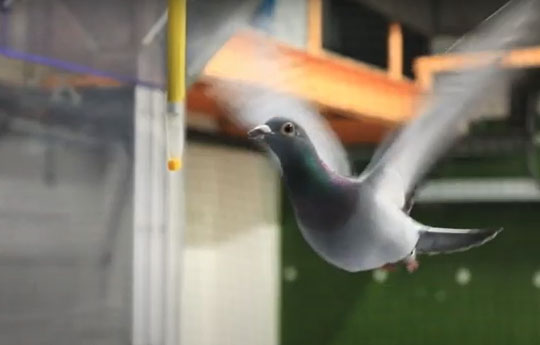Anyone who has travelled on a plane will realise how important the weather is for flight: Wind and turbulence affect the routes that planes take, the total flight time and the amount of fuel needed.
What the air is doing is every bit as important for birds in flight, whether they are on their daily commute, their annual migration or choosing where to nest. But it can be challenging to unravel these relationships as air is both invisible and almost always on the move.
The Method
We use a range of techniques to quantify animal movement, second by second, to understand how much it costs, and how animals respond to our changing world.
New 20T, tilting wind tunnel to study bird flight
The wind tunnel is a new facility designed to enable collaborative research on animal flight between biologists and engineers. It has a large test area where birds fly (1.8 m wide by 1.5 m high by 2.2 m long). Accelerating air through such a large volume requires a big structure to house the fans, reduce fan noise and minimise the turbulence of the airflow. The tunnel itself also tilts, enabling the study of climbing and gliding flight. The end result is a tunnel > 17 m long and weighing > 20T. All this to improve our understanding of birds that weigh about the same as a can of beans.
We attach miniature, high-frequency data-loggers to birds to record the details of their wingbeats in the wind tunnel and relate that to the energy that their flight requires. We use the same loggers on birds flying in the wild to quantify how the wind and turbulence affects their flight costs and decisions.
Visualising the invisible
When it comes to choosing where to nest, it turns out that not all cliffs are equal. The exposure to the prevailing wind can predict where common guillemots breed. This type of modelling could be important for management decisions, particularly where colonies have been lost, potentially allowing people to predict which areas species may return to/ should be encouraged back to. This is pertinent for the many seabirds that have experienced dramatic population declines in the last century.
Our team used computational fluid dynamics models, borrowed from engineering, to visualise and map what the air is doing over fine scales and estimate the wind and turbulence experienced by seabirds close to their nesting cliffs.
Tag development in the Swansea Lab for Animal Movement (SLAM)
The Swansea Laboratory for Animal Movement, SLAM, uses individual-based approaches to examine how, why, and where animals move. We specialise in novel animal tagging techniques, and continue to develop the sensors deployed on animals, the best methods of attaching them, as well as metrics to inform ecologists about animal motion and its energetic costs (notably through Dynamic Body Acceleration).
This gives us new eyes on animals, whether they be condors soaring hundreds of metres above the Andes, lions tracking the borders of a reserve, or penguins twisting and turning in pursuit of prey underwater.
Professor Emily Shepard is funded by an ERC started grant, awarded under the European Union’s Horizon 2020 research and innovation program. She has also received funding from The Leverhulme Trust and the National Geographic Global Exploration Fund.
The Impact
The teams findings on Andean condors, which were reported in a recent paper showed just how adept these birds are at finding rising air, spending just 1% of their flight time flapping. They recorded a flight from one bird that travelled over 100 miles without a single wingbeat.
Further collaborative work on how gulls soar above buildings could help when it comes to planning flight paths for unmanned aerial vehicles (UAVs) and drones in urban landscapes. In a similar way to birds, these are affected by gusts and turbulence, far more than larger aircraft. Flying at low altitudes in close proximity to terrain and buildings is challenging, as flight control systems have not been developed to cope with complex urban environments
Understanding where seabirds nest could also be important for management decisions, allowing people to predict which areas species may return to. This is pertinent for the many species that have experienced dramatic population declines in the last century.













